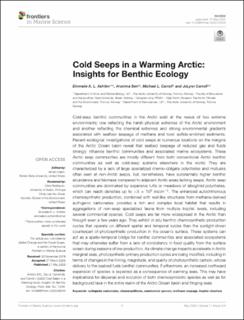| dc.contributor.author | Åström, Emmelie | |
| dc.contributor.author | Sen, Arunima | |
| dc.contributor.author | Carroll, Michael Leslie | |
| dc.contributor.author | Carroll, JoLynn | |
| dc.date.accessioned | 2020-07-07T09:46:11Z | |
| dc.date.available | 2020-07-07T09:46:11Z | |
| dc.date.created | 2020-05-29T10:44:06Z | |
| dc.date.issued | 2020 | |
| dc.identifier.citation | Åström, E., Sen, A., Carroll, M. L. & Carroll, J. (2020). Cold seeps in a warming Arctic: Insights for benthic ecology. Frontiers in Marine Science, 7: 244. doi: | en_US |
| dc.identifier.issn | 2296-7745 | |
| dc.identifier.uri | https://hdl.handle.net/11250/2660940 | |
| dc.description.abstract | Cold-seep benthic communities in the Arctic exist at the nexus of two extreme environments; one reflecting the harsh physical extremes of the Arctic environment and another reflecting the chemical extremes and strong environmental gradients associated with seafloor seepage of methane and toxic sulfide-enriched sediments. Recent ecological investigations of cold seeps at numerous locations on the margins of the Arctic Ocean basin reveal that seabed seepage of reduced gas and fluids strongly influence benthic communities and associated marine ecosystems. These Arctic seep communities are mostly different from both conventional Arctic benthic communities as well as cold-seep systems elsewhere in the world. They are characterized by a lack of large specialized chemo-obligate polychetes and mollusks often seen at non-Arctic seeps, but, nonetheless, have substantially higher benthic abundance and biomass compared to adjacent Arctic areas lacking seeps. Arctic seep communities are dominated by expansive tufts or meadows of siboglinid polychetes, which can reach densities up to >3 × 105 ind.m–2. The enhanced autochthonous chemosynthetic production, combined with reef-like structures from methane-derived authigenic carbonates, provides a rich and complex local habitat that results in aggregations of non-seep specialized fauna from multiple trophic levels, including several commercial species. Cold seeps are far more widespread in the Arctic than thought even a few years ago. They exhibit in situ benthic chemosynthetic production cycles that operate on different spatial and temporal cycles than the sunlight-driven counterpart of photosynthetic production in the ocean’s surface. These systems can act as a spatio-temporal bridge for benthic communities and associated ecosystems that may otherwise suffer from a lack of consistency in food quality from the surface ocean during seasons of low production. As climate change impacts accelerate in Arctic marginal seas, photosynthetic primary production cycles are being modified, including in terms of changes in the timing, magnitude, and quality of photosynthetic carbon, whose delivery to the seabed fuels benthic communities. Furthermore, an increased northward expansion of species is expected as a consequence of warming seas. This may have implications for dispersal and evolution of both chemosymbiotic species as well as for background taxa in the entire realm of the Arctic Ocean basin and fringing seas. | en_US |
| dc.language.iso | eng | en_US |
| dc.publisher | Frontiers | en_US |
| dc.rights | Navngivelse 4.0 Internasjonal | * |
| dc.rights.uri | http://creativecommons.org/licenses/by/4.0/deed.no | * |
| dc.title | Cold seeps in a warming Arctic : Insights for benthic ecology | en_US |
| dc.type | Peer reviewed | en_US |
| dc.type | Journal article | en_US |
| dc.description.version | publishedVersion | en_US |
| dc.rights.holder | © 2020 The Author(s) | en_US |
| dc.subject.nsi | VDP::Matematikk og Naturvitenskap: 400::Zoologiske og botaniske fag: 480::Marinbiologi: 497 | en_US |
| dc.subject.nsi | VDP::Matematikk og Naturvitenskap: 400::Zoologiske og botaniske fag: 480::Økologi: 488 | en_US |
| dc.source.pagenumber | 25 | en_US |
| dc.source.volume | 7 | en_US |
| dc.source.journal | Frontiers in Marine Science | en_US |
| dc.identifier.doi | 10.3389/fmars.2020.00244 | |
| dc.identifier.cristin | 1813176 | |
| dc.relation.project | Norges forskningsråd: 228107 | en_US |
| dc.description.localcode | Unit Licence Agreement | en_US |

